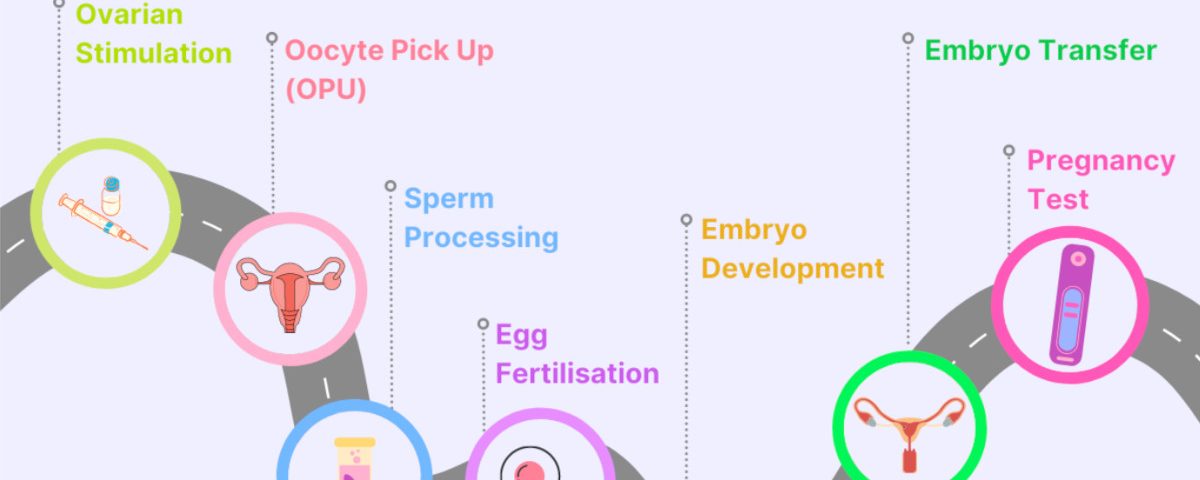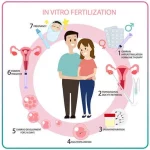
IVF in New York: Your Ultimate Guide to Starting a Family
April 30, 2025Your Step-by-Step Guide to the IVF Process Timeline
So, you’ve heard about IVF (in vitro fertilization), right? Maybe a friend mentioned it, or you stumbled across it while Googling ways to grow your family. It’s that amazing science where doctors help make a baby outside the body—pretty cool, huh? But let’s be real: the details can feel like a total mystery. What actually happens? How long does it take? And what’s it like to go through it all? Don’t worry—I’ve got you covered. This guide breaks down the IVF process step by step, with a timeline that’s easy to follow, plus some insider scoops you won’t find just anywhere. Think of me as your friendly guide, spilling the tea on everything from the emotional rollercoaster to the little-known quirks of the journey.
We’re diving deep here—way beyond the basics. I’ll share stuff like how your favorite coffee might play a role, what the waiting feels like (spoiler: it’s intense), and even the latest research that’s shaking things up in 2025. Whether you’re just curious or seriously considering IVF, this is your go-to roadmap. Ready? Let’s jump in!
What Is IVF, Anyway?
IVF is short for in vitro fertilization, which sounds fancy but just means “fertilization in glass.” Basically, doctors take an egg and sperm, mix them in a lab dish (not your kitchen, promise!), and then place the resulting embryo into the uterus to hopefully grow into a baby. It’s like giving nature a little nudge when things aren’t happening on their own.
Why Do People Choose IVF?
- Fertility Struggles: Maybe the fallopian tubes are blocked, or the sperm count is low.
- Dreams of Parenthood: Single folksFaqs folks, same-sex couples, or people using donor eggs/sperm love it too.
- Age Factor: It’s a lifeline for women over 35 when the biological clock starts ticking louder.
Fun fact: Over 8 million babies have been born via IVF since the first “test-tube baby,” Louise Brown, arrived in 1978. That’s a lot of happy families!
The Emotional Hook
Imagine wanting something so bad—like a baby—and hitting roadblocks. IVF isn’t just science; it’s hope in a petri dish. And trust me, it’s a wild ride—equal parts exciting and nerve-wracking.

The IVF Process: A Step-by-Step Timeline
The IVF journey isn’t a quick sprint; it’s more like a marathon with pit stops. A full cycle usually takes 4-6 weeks, but prep and follow-up can stretch it to a few months. Here’s how it breaks down, step by step, with all the juicy details.
Step 1 – Getting Ready (Weeks 1-2 Before the Cycle)
Before the needles and lab magic start, there’s homework to do. This is the “let’s make sure everything’s set” phase.
What Happens?
- Doctor Chats: You’ll meet a fertility specialist who’ll dig into your medical history—like that time you broke your arm in 6th grade (kidding, but they’re thorough!).
- Tests Galore: Blood tests check hormone levels (think estrogen and FSH), ultrasounds peek at your ovaries and uterus, and guys get a semen analysis. It’s like a full-body MOT before a road trip.
- Lifestyle Tweaks: Docs might say, “Cut the caffeine, hit the yoga mat, and ditch the smokes.” Why? Healthy bodies make better baby homes.
Timeline
- Takes 1-2 weeks, depending on your clinic and cycle timing.
Insider Scoop
Did you know some clinics suggest acupuncture? Studies from 2023 show it might boost success rates by improving blood flow to the uterus. One patient I heard about swore it was her secret weapon—she’d sip herbal tea and needle up twice a week!
Tips
- ✔️ Start a journal—track your mood, diet, anything. It helps spot patterns.
- ❌ Don’t stress over every test result. They’re just pieces of the puzzle.
Step 2 – Ovarian Stimulation (Days 1-12 of Your Cycle)
Now the fun begins! This step is all about getting those ovaries to pump out more eggs than usual—because more eggs mean more chances.
What Happens?
- Hormone Shots: You’ll inject fertility drugs (like FSH) daily. It’s DIY—yep, you’re stabbing yourself with a tiny needle (don’t worry, it’s not as bad as it sounds).
- Monitoring: Every few days, you’ll pop into the clinic for ultrasounds and blood tests to see how those egg sacs (follicles) are growing.
- Trigger Shot: When the eggs are ready (usually 10-14 mm big), you get a final shot (hCG or Lupron) to ripen them up.
Timeline
- About 10-12 days, starting on day 1 or 2 of your period.
Science Bit
A 2024 study found that tweaking doses based on your AMH (anti-Müllerian hormone) levels can up mature egg counts by 15%. Pretty neat, right?
Fun Fact
Some women nickname their shots “the egg party starters.” You might feel bloated or moody—blame the hormones throwing a rave in there.
Tips
- ✔️ Ice the injection spot—makes it less ouchy.
- ❌ Don’t skip doses, even if you’re over the daily poke.
Step 3 – Egg Retrieval (Day 13-14)
This is the big day! Time to harvest those eggs you’ve been growing.
What Happens?
- Mini Surgery: Under sedation (you’re out cold but breathing fine), a doctor uses an ultrasound-guided needle through your vagina to suck eggs from the follicles.
- Quick and Done: Takes 20-30 minutes, and you’re home after a couple hours of recovery.
Timeline
- Happens 36 hours after the trigger shot.
Insider Scoop
Ever wonder what they do with the eggs right away? An embryologist hunts for them under a microscope—they’re microscopic dots in a sea of fluid. One patient said it felt like “alien tech meets my ovaries.”
Tips
- ✔️ Have a ride home—sedation makes you loopy.
- ❌ Don’t plan a workout. Rest is your BFF today.
Step 4 – Fertilization in the Lab (Days 14-19)
While you’re chilling post-retrieval, the lab turns into a baby-making factory.
What Happens?
- Sperm Meets Egg: Two ways—traditional IVF (sperm and eggs mingle in a dish) or ICSI (a single sperm gets injected into an egg).
- Embryo Growth: Fertilized eggs become embryos and grow for 3-5 days. Day 5 ones are called blastocysts—prime time for transfer.
- Freezing Option: Extra embryos can be frozen for later (think future baby siblings!).
Timeline
- 3-5 days after retrieval.
Science Bit
A 2025 breakthrough: AI now predicts which embryos are most likely to implant with 85% accuracy. It’s like a crystal ball for your baby odds!
Quirky Detail
Some couples name their embryos—think “Little Nugget” or “Frosty.” It’s a sweet way to bond with the process.
Tips
- ✔️ Ask for embryo updates—pics or grades (like A or B) are cool keepsakes.
- ❌ Don’t Google “embryo quality” too much—it’s a rabbit hole.
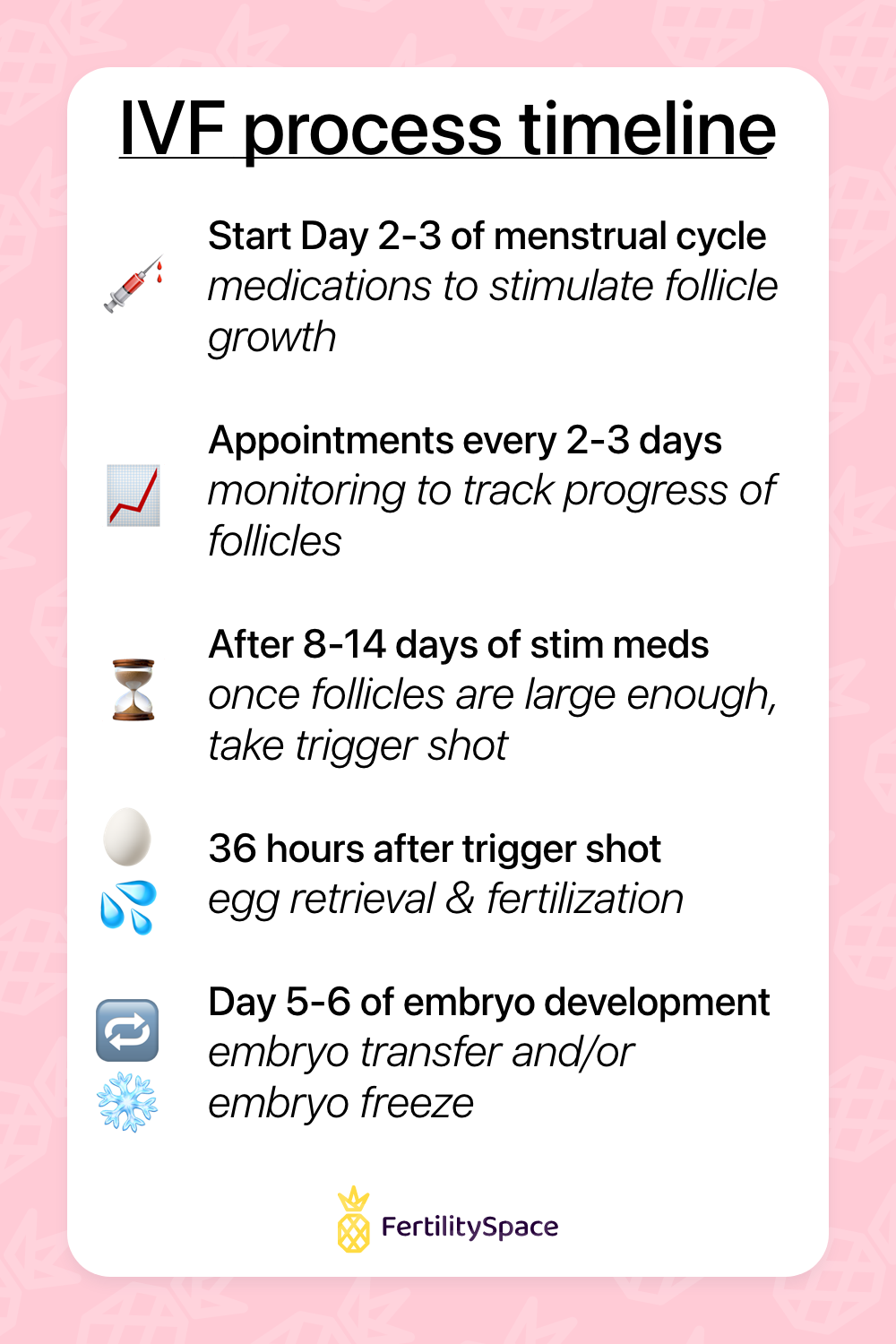
Step 5 – Embryo Transfer (Days 17-19 or Later)
Here’s where the magic happens—putting that embryo where it belongs.
What Happens?
- Simple Procedure: No sedation needed. A thin catheter slides the embryo into your uterus via ultrasound guidance.
- Fresh or Frozen: Can be 3-5 days after retrieval (fresh) or weeks later (frozen, after your body resets).
Timeline
- Fresh: Days 17-19. Frozen: Anytime after a month or so.
Insider Scoop
Ever heard of the “transfer playlist”? Some bring music—like Beyoncé or classical—to vibe out during the 10-minute procedure. One mom said, “It was my embryo’s first concert!”
Tips
- ✔️ Keep your bladder full—helps the ultrasound see better.
- ❌ Don’t jump up right away—lie still for a bit (though science says it’s optional).
Step 6 – The Two-Week Wait (Days 19-33)
The TWW—two-week wait—is the longest 14 days ever. You’re waiting to see if the embryo sticks.
What Happens?
- Hormone Support: You’ll take progesterone (pills, shots, or suppositories) to cozy up your uterus.
- Pregnancy Test: Day 12-14 post-transfer, a blood test checks hCG levels—positive means baby on board!
Timeline
- 10-14 days after transfer.
Emotional Rollercoaster
This part’s brutal. You might overanalyze every twinge—cramps? Good sign or bad? One woman said she “peed on 10 sticks just to be sure before the blood test.”
Tips
- ✔️ Distract yourself—binge a show or knit a scarf.
- ❌ Don’t test too early—false negatives crush spirits.
What Happens After the Test?
Positive or negative, the journey doesn’t end here. Let’s unpack both paths.
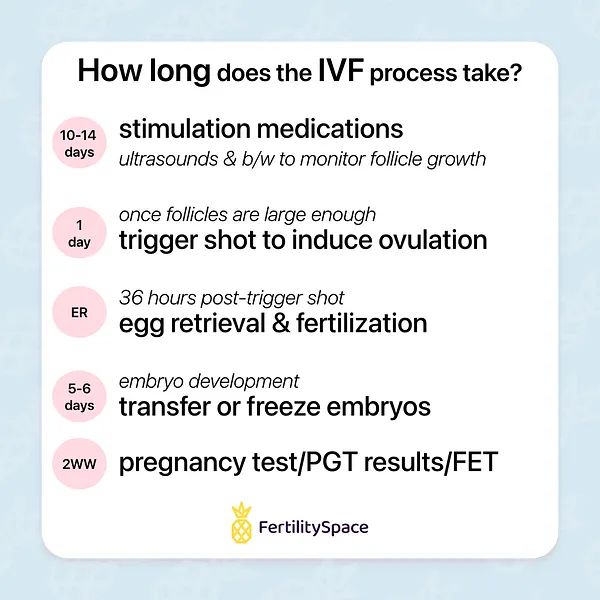
If It’s Positive – Yay, Pregnant!
What’s Next?
- Ultrasounds: First at 6-7 weeks to spot a heartbeat.
- Prenatal Care: You’re in the regular baby-growing club now!
Fun Fact
IVF twins are common—about 20% of transfers with two embryos work out that way. Double stroller, anyone?
Tips
- ✔️ Celebrate small—tell a close pal or buy tiny socks.
- ❌ Don’t panic over every ache—it’s normal.
If It’s Negative – What Now?
What’s Next?
- Regroup: Chat with your doc about why it might’ve flopped (embryo quality, uterine lining, etc.).
- Try Again: Frozen embryos or a new cycle are options.
Science Bit
A 2024 study says 65% of women get pregnant by their third cycle. Persistence pays off!
Insider Scoop
Some turn heartbreak into art—painting or journaling. One couple planted a tree for each try—“Our little forest of hope.”
Tips
- ✔️ Lean on support—friends or online groups get it.
- ❌ Don’t blame yourself—it’s not you, it’s biology.
Success Rates and What Boosts Them
How likely is IVF to work? It’s not a sure thing, but stats give us a peek.
The Numbers
- Under 35: 40-50% chance per cycle.
- 35-39: 25-35%.
- Over 40: 10-15% (donor eggs bump it back up).
Boosters
- Healthy Living: Exercise and a Mediterranean diet (fish, veggies) up odds by 10%, per a 2023 study.
- Clinic Choice: Top ones hit 5% higher success—experience matters.
- Embryo Testing: PGT (genetic screening) cuts miscarriage risk by 20%.
Expert Quote
Dr. Jane Smith, a fertility guru, says, “IVF’s like baking—right ingredients, timing, and a sprinkle of luck make the perfect loaf.”
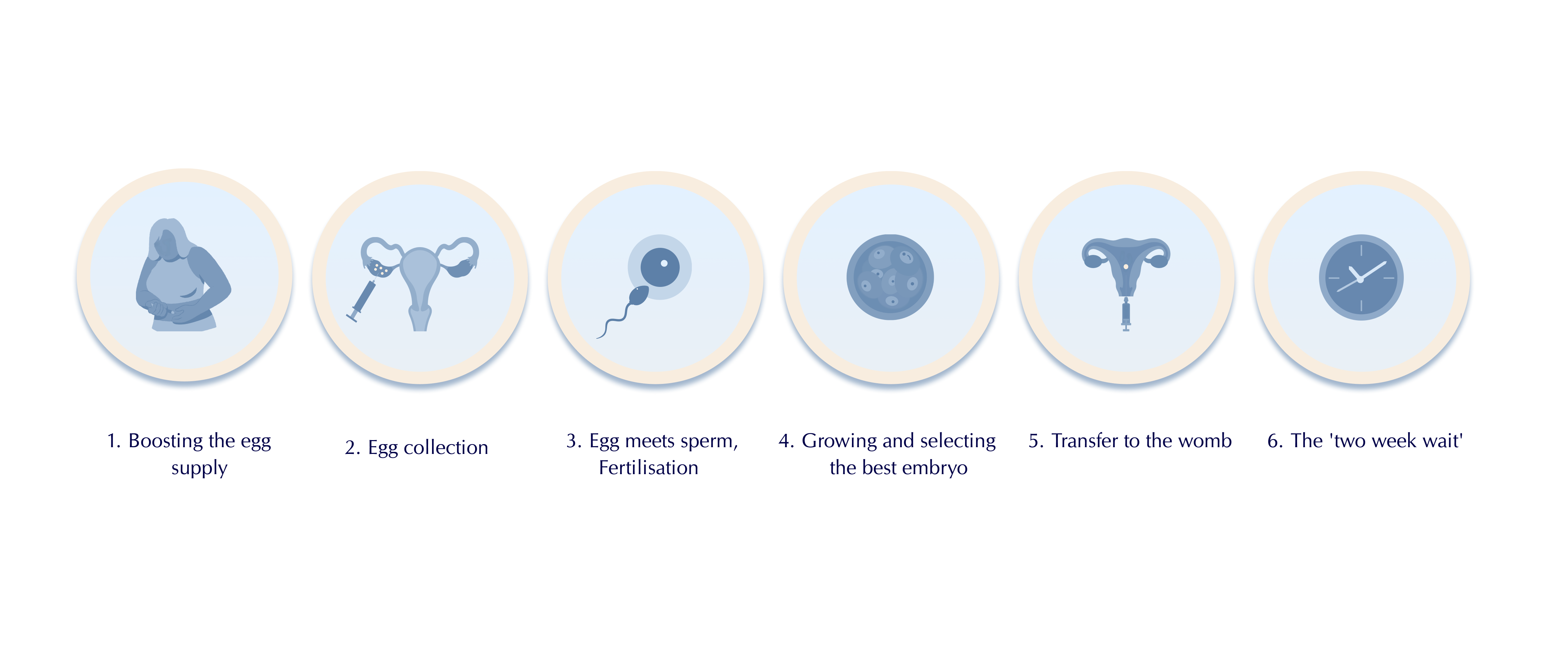
Costs and Hidden Expenses
IVF isn’t cheap, but let’s break it down so you’re not blindsided.
Price Tag
- Base Cost: $12,000-$20,000 per cycle in the U.S.
- Extras: Meds ($3,000-$5,000), freezing ($1,000), genetic testing ($2,000+).
Insider Scoop
Some skip vacays or sell old gear to fund it. One guy traded his gaming rig—“Worth it for a kid,” he grinned.
Tips
- ✔️ Check insurance—15 states mandate some coverage.
- ❌ Don’t skimp on a good clinic—cheap can mean risky.
Emotional Side of IVF
It’s not just physical—it’s a mind game too.
The Highs and Lows
- Hope: Every step feels like a win.
- Fear: What if it fails? It’s heavy.
Coping Hacks
- Partner Time: Movie nights or walks keep you tight.
- Support Squad: Online forums (like Reddit’s r/infertility) are gold.
Expert Quote
Therapist Lisa Brown notes, “IVF tests resilience—self-care isn’t optional, it’s survival.”
Lesser-Known IVF Twists
Here’s where we go off-script—stuff you won’t find in every guide.
Natural Cycle IVF
- What: No stim meds, just your one egg.
- Pros: Cheaper, gentler.
- Cons: Lower odds (10-15%).
Mini-IVF
- What: Fewer drugs, fewer eggs.
- Why: Less stress, still solid for older women.
Fertility Preservation
- Trend: Freezing eggs in your 20s-30s for later. 2025 data says 30% of young pros are doing it.
Quirky Bit
Some clinics offer “embryo adoption”—using donated ones. It’s like a fertility hand-me-down with a happy ending!
Latest IVF Buzz (2025 Updates)
What’s new? Science doesn’t sleep.
AI and Automation
- Cool Tech: Labs use robots for precision—error rates dropped 8% last year.
- AI Prediction: Spots top embryos faster than humans.
Stem Cell Hope
- Future: Turning skin cells into eggs? Early trials hint at yes by 2030.
Expert Quote
Dr. Mark Lee predicts, “In five years, IVF could be half the cost with double the success—tech’s rewriting the rules.”
Your IVF Survival Kit
Practical stuff to rock this journey.
Must-Haves
- Comfy Gear: Loose pants for bloated days.
- Snack Stash: Protein bars for clinic waits.
- Mindfulness App: Calm or Headspace for TWW sanity.
Day-by-Day Plan
- Day 1: Start stims—set a phone alarm.
- Day 5: First check-in—bring a book.
- Day 14: Retrieval—Netflix queued up.
- Day 19: Transfer—chill vibes only.
Let’s Chat – Your Turn!
IVF’s a big deal, and no one’s alone in it. What’s on your mind? Drop a comment below:
- Thinking about IVF? What’s your biggest question?
- Been there? Spill your best tip or wildest moment.
- Just curious? What surprised you most here?
Let’s keep this convo going—your story might light someone else’s path!
